Article originally commissioned for 16:9 Magazine of Australia
But I get so many emails asking, should I buy a 5dmk2 instead of X, Y or Z that I have taken that article and greatly expanded it so hopefully it will answer many questions.
DSLRs, the death of 35mm Adaptors?
By Philip Bloom
Last year, out of the blue I suddenly heard of the Nikon D90. A digital SLR that shoots 720p 24p video with 35mm lenses? Really?! So of course I wanted one, and not having much patience I bought it from B&H Photo Video in New York as I could get it a week early!
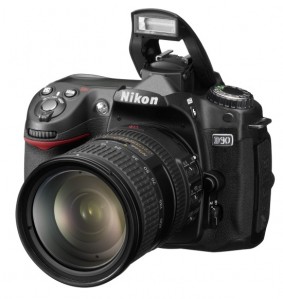
So it arrived, I went out and shot some stuff… wow, did it have issues! The sensor looked like it was made out of Jelly and getting focus was a huge issue, but it did work very nicely in low light. For me, the rolling shutter issues and the lack of audio input made it a cool toy, a great stills camera but not such a great video camera. I was disappointed. It could have been so great. But this was the first of a new breed and something that will change the camera landscape for all of us.
How did I get to the point, where the notion of a DSLR that could shoot high-definition video became so appealing? Well, for those of you who aren’t familiar with the 35mm adaptor revolution, let me recap…
For two and a half years now I have been using and experimenting with 35mm adaptors extensively. What is a “35mm adaptor” you ask? Well it’s a way of giving your video a film-look by using special adaptors that provide the depth of field (DOF) characteristics of 35mm film on your bog standard 1/3″ chip or similar video camera. You can use them on 2/3″ cameras as well, but it’s in the small chip market that these adaptors really excel.
I have bought just about every one that has come out so far. The Letus flip-enhanced, the Redrock M2, Cinevate’s Brevis, the Letus Extreme, Letus Ultimate, Shoot 35 Blade, Cinemek G35, Jag35… the list goes on.
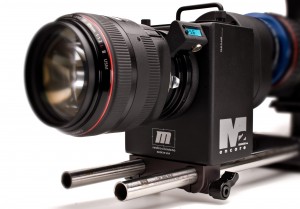
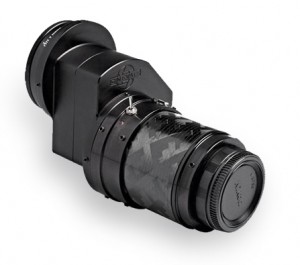
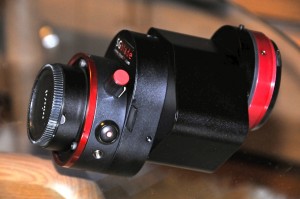
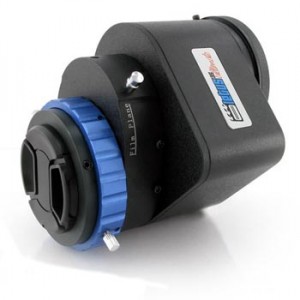
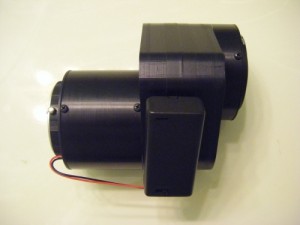
You see, when I first got a Sony Z1 to play with it was my first proper experience with a small-chip professional camera, I had been shooting Betacam up until then (with 2/3″ sensors) and was shocked that with the Z1 I just couldn’t knock that background out of focus. So I looked into it, understood the physics behind it and found out about these adaptors.
The basic principal behind the adaptors is that you have a piece of ground glass (glass with a fine grain pattern in it) approximately the same size as a frame of 35mm film, which is placed inside a housing with threads for your video camera’s lens on the back and a 35mm lens mount (generally an SLR lens mount) on the front. With an adaptor mounted to your camera, the image is projected through your 35mm lens onto the ground glass (which is vibrated or spun at high speed to disperse the pattern of the grain), and it is this projected image from the 35mm lens that the stock lens of your video camera records. You simply zoom in and focus your camera’s lens on the ground glass element and hit record. Voila! 35mm DOF characteristics. Very clever.
Now the problems with the early adaptors were that you had huge amounts of light loss (sometimes as much as three stops), and the image from your 35mm lenses was projected upside down, which meant you had the image recorded upside down, which obviously causes considerable issues in regards to monitoring your footage whilst shooting and in post production.
However, with time things got better. Cinevate came out with the Brevis with very little light loss then Letus came out with the Extreme which had a built in optical flip and just half a stop of light loss. This for me was the game changer. I do most of my shooting in England, and prior to this, it was bloody tricky with these beasts. Big lights were needed for interiors, exteriors were fine as long as we had some sunshine! But now with the Letus I could essentially “light for video”.
It’s been eighteen months since the Letus Extreme came out and it has been a great tool to use. I have since upgraded to the spinning glass Ultimate as it allows me to stop down to f22 and not see any patterning on the glass, something that you get on vibrating adaptors at anything smaller than f5.6
Due to the necessity of using rails with the adaptors (to support their weight, as well as matte boxes and follow focus units) they are still really hard to use handheld. Fortunately there are some good solutions out there, especially by the Chicago-based Zacuto, who make a superb, but pricey rig that makes handheld usage really easy and well balanced. Which is essential in my opinion. Tripod stuff of course is much easier. The thing is, with these adaptors, once you start to use them you fall in love with the image, it is just beautiful. Also, having the ability to get such incredibly shallow DOF is unheard of in video cameras apart from the 35mm sensor ones like Panavision Genesis or the F35 and of course the RED ONE.
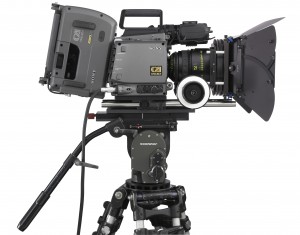
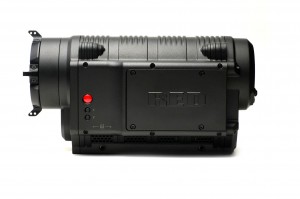
Whenever I shoot actuality, I ditch the adaptor and go “naked” but whenever I can I put the Letus on and love what I get…
Now, this brings us back to DSLRs. These are light, affordable, have large sensors (in the case of the Canon 5DII a full-frame 35mm sensor) and give you the ability to have shallow DOF without the hassles of an adaptor. Surely this is a dream come true, as up until now, to get 35mm sensors you’ve been looking at the F35, the Red One, the Genesis et all as I mentioned above… could these DSLRs bring 35mm-sized sensors within the grasp of almost every filmmaker? The answer is yes… and no.
First off let’s talk about the main player in this new DSLR video field. The Canon 5D MkII. It is capable of quite extraordinary images and astonishing low light performance, but is hampered by recording only in 30p, 12 minute record chunks, awful audio features and having a really poor lack of manual controls. Personally I have gotten around some of these issues with the 5D MkII by using a lens mount adaptor and Nikon lenses with manual apertures. Which allows me to get my shallow DOF, but I still have no control over the shutter and I have to do a very fiddly ISO lock trick to get the ISO I want. But the sensor is also much bigger than cinema 35mm sensors due to the way actual film was designed to go through the gate.
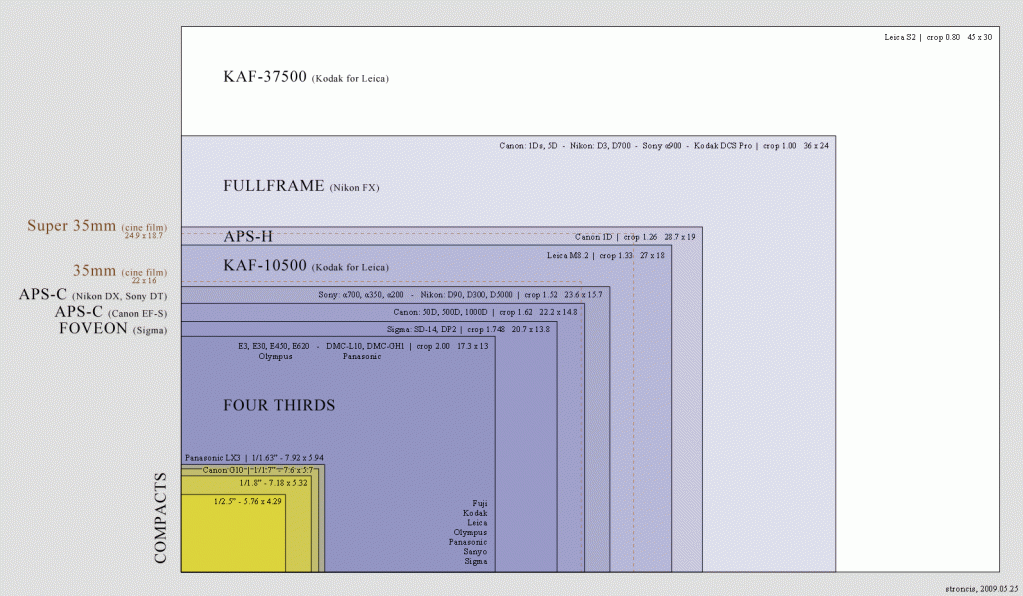 Also the sensor suffers really badly from wobble from the electronic shutter, it is not as bad as the D90, but it is there. Meaning any real movement with the camera is not a good idea. Don’t forget, this camera is a stills camera that has been given a video mode so that sensor is far from optimised for video.
Also the sensor suffers really badly from wobble from the electronic shutter, it is not as bad as the D90, but it is there. Meaning any real movement with the camera is not a good idea. Don’t forget, this camera is a stills camera that has been given a video mode so that sensor is far from optimised for video.
The new kid on the block is the Panasonic Lumix GH1. Now, I have been lucky enough to have been trying this out for two weeks whilst in the US. It has a smaller sensor, about half the size of the 5D MkII’s sensor, but has so many features on it that 5D MkII owners (like me) are drooling over. Crazy science fiction features like manual shutter! Manual Iris! Manual ISO! Crazy! It also has a terrific auto focus feature that is totally silent and can pick out faces and track them for focus. Not only that but you can also program it to remember certain people’s faces so it will pick them out if you tell it too!
Like the Canon it has a mic input, but also like the Canon still has no headphone jack for monitoring the audio you are recording.
It also has a neat swivel screen so you can see the LCD at any angle, really handy. On top of that, because the “four-thirds” camera system employed by Olympus and Panasonic has junked the old SLR mirror system, you have an electronic viewfinder (EVF) that you can use in video mode. On both the D90 and 5D MkII you have to use “live mode” which uses the LCD screen only, as the cameras’ optical viewfinders are not usable when in video mode because the mirror is locked up to expose the sensor. Using the EVF gives you much steadier handheld footage, couple that with the camera’s built-in image stabilisation and it is pretty good operating this way.
The GH1 performs really well, is super light. Has good low light performance (not a patch on the Canon but still pretty good). It records in AVCHD, a proper video format unlike the Canon’s awkward H264 format. But its codec isn’t that strong and it has a low bit rate of 17mbps, which would normally be okay on a true video camera but for some reason the 17mbps on the GH1 does not look as good on this camera as on some consumer video cameras.
Personally I have found shooting in 720p mode on the GH1 gives me a stronger image to work with, but on my PAL camera it only shoots 50p, not 25p (in a 50i stream) like the full HD mode. But this isn’t a big problem. Stick it on a 25p timeline and it works a treat, or change the timebase in Apple’s Cinema Tools to 25p and you get nice slow motion! USA cameras get 24p in a 60i stream and 60fps in 720p mode. It also can record in 30 minute chunks, better than the 12 minute Canon’s, but still nowhere near as good or practical as continuous recording offered by cameras like the Sony EX1.
Now, there are rumours that Canon are coming out with a 24p firmware upgrade for the 5D MkII that may or may not give you better manual controls (manual control now confirmed with launch of 2nd June firmware!). But even with this, these DSLRs still can’t replace proper video cameras. They are great tools to have, great for certain situations, but the ergonomics, the audio recording, the very poor sensor wobble, the lack of basic video camera things like headphone jack, ND filters, XLR inputs all make these hybrid cameras additions, rather than replacements for proper video cameras.
Also there are some really cheap 35mm adaptors out there for hobbyists. Jag35.com have a static adaptor for $99 and a spinning one for about $370 dollars. Stick on that on a cheap Canon HV20 and the results are wonderful and film like.
For me, with any paid work, It’s still a full size camera or my Sony EX3/1 with Letus Ultimate (or equivalent) as it still produces stunning images, works like a video camera, operates like a video camera. Has great functions like over and undercranking, has XLR inputs, ND filters, a headphone jack (!) etc… and of course can actually handle movement! Of course there is also with the ability to switch cards whilst recording the ability to continuously record unlike the 5dmk2 and the GH1.
The 5D MkII is being used professionally by many people as a video camera. Many wedding videographers use them due to their incredible low light. Rodney Charters of 24 fame, has recently shot a TV pilot using I believe 4 5dmk2s with modified firmware to make it 24p. I even heard a rumour that 2 of them are being used on the set of the new “Harry Potter” film. Also the US military is using them as they shoot stills and video. Check out Tyler Ginter’s work on Vimeo.
The day of the DSLR killing the 35mm adaptor isn’t too far away, maybe three years? Even then killing is a strong word, there will still be a market for them as not everyone can afford a 5dmk2! But, until then, 35mm adaptors still are an essential part of my kit and I will continue to shoot commercials, documentaries and everything else on them. My 5D MkII will be my little project camera and my B camera, although I am getting enquiries about hiring me with the Canon as my main camera… My GH1 is my “go anywhere” camera. It will live in my bag, not just on vacations, but wherever I go. It’s small and produces astounding video and stills. But my EX3/1 and Letus combo will still be my main breadwinner for the next two years. Don’t be fooled into thinking DSLRs have superseded them, they haven’t. Not yet! But I do have a number of low budget, low light drama projects coming up and without a doubt it 5dmk2 all the way!
So where does that leave the 35mm adaptor manufacturers in two years time? Well they have been branching out for quite a while now. Redrock make the best high end cheap Mattebox out there and even make a cracking shoulder rid for the 5dmk2. Cinevate have some incredible bits of gear, great Dollys and also make a great Canon rig! On the high end of the market Letus have just brought out some great relays for 1/2″ and 2/3rd” cameras. Now, this is expensive gear and especially the B4 relays, but they will be used on very expensive cameras for big productions no doubt, cameras with much less compression than DSLRs using super reliable recording formats. That’s another bad thing about the 5d. It records in quicktime H264. A lovely finishing format, but a HORRIBLE format to edit with, so everything needs transcoding before editing and that takes time…
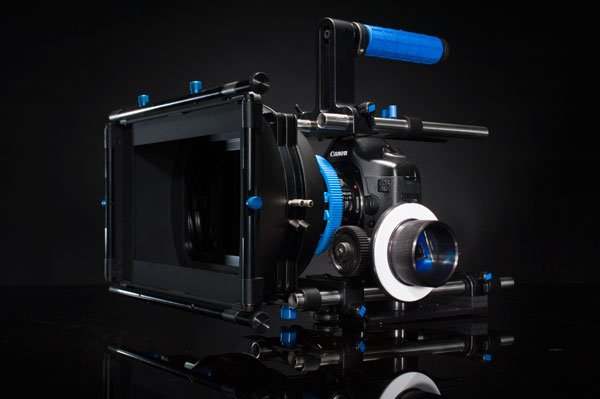
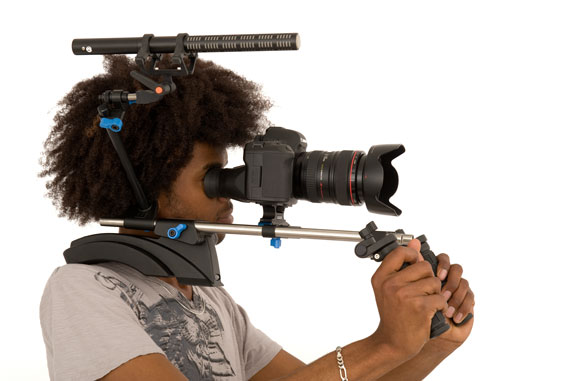
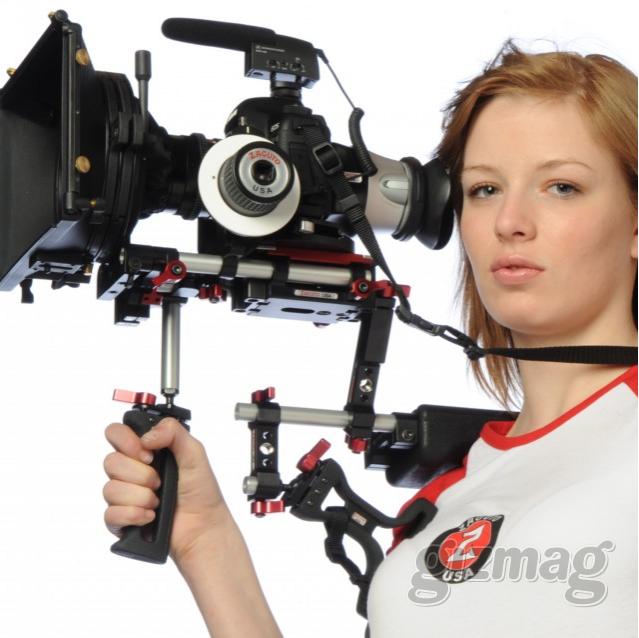
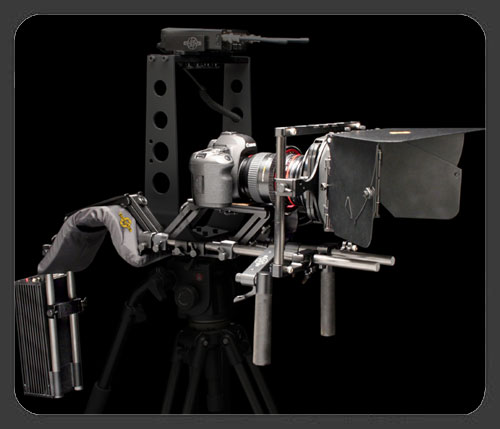
I will be hopefully soon be doing a video showing off all the main three DSLR rigs, just hoping to get hold of the Cinevate one too.
The video and stills world appears to be heading towards total convergence, and big companies like Panasonic, Sony and Canon, with separate divisions for still and video will now for the first time, have to start talking to each other and take what they can both do to make killer combos. With the RED’s Scarlet camera on the horizon too, I suspect the landscape of video cameras will be almost unrecognisable in around three to four years time. Wouldn’t it be great to have the sensors of the Canon 5dmk2 in bodies of cameras like the HPX 300 and still keep the same pricepoint?
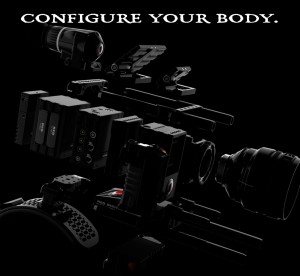
I am lucky enough to be in position to own both video DSLRs and 35mm Adaptors with video cameras. For me, it really is the right tool for the right job. Tomorrow I fly to Boston to shoot a documentary for UK channel More4. What am I shooting on? The Letus Ultimate and EX1. Would I like to shoot on the 5dmk2? Sure, nice and small and a lot less kit to fly with (the bane of my life!), but all the limitations and as most of it is talking heads, so 12 minutes clip lengths just don’t work for me. Also the workflow of the EX cameras with SxS is so fast, easy and reliable. The rewrapping to .mov for FCP editing is super fast as is transferring off the card. So I will be sticking with my tried and tested combo…things will change though eventually. They have to, and faster than anyone could have predicated a year ago.
Will we have what the American’s call “Soccer Moms” out shooting their kids on the fixed lens Scarlet or a 5D MkII? I doubt it. I gave my 5dmk2 to a friend at a BBQ at the weekend, with the Zacuto Z-Finder on, and she said “It’s so hard to focus, I hate it!” There is still going to be a market for cheap small chip cameras that hide a huge amount of operator mistakes, after all the bigger the sensor, the harder it is to get it right! Mind you saying that, the Lumix GH1 has an incredible auto focus feature on the stock lens, making it possible to just point and shoot for amateurs and that’s got a pretty decent sized sensor in that!
I love what I have been able to get with the Canon 5dmk2 and GH1. I have shot a few things on them recently and I am really impressed. Sofia’s People, Kauai Sunset, Always Returning and Joshua Tree. But do check out stuff I have done on the Letus Ultimate and EX3 around the same time…Rhyolite Ghost Town, Wondrous Place and NT Live.
So what is next? What is Nikon’s response going to be to the Canon 5dmk2? Especially with no video market to protect, rumours of a D400 and D750 are rife. What about Sony with their Alpha range? They are in more delicate position than Panasonic as they have a true DSLR on the market and they also have their enormous video range. Surely they cannot ignore what their DSLR rivals are doing but in doing so how much will it affect their video line? But still, if Sony do bring out a shoulder mounted ex camera like an EX5 I will be getting that for sure. It would be a terrific camera and work brilliantly with the Letus and Relay
Personally I say bring it on. There never has been a more exciting time in video cameras than right now!
EDIT: 27th May 2009. FULL MANUAL CONTROL FOR 5dmk2 on JUNE 2nd. Final Cut Pro 7 WILL feature native h264 editing. Amazing news and changes a lot!! http://philipbloom.co.uk/2009/05/27/full-manual-control-for-the-canon-5dmk2-in-early-june/#more-3426
Philip Bloom is a London based DP and Director. He has been shooting for 20 years and is at the forefront of shooting with 35mm adaptors and DSLRs. His website is www.philipbloom.co.uk

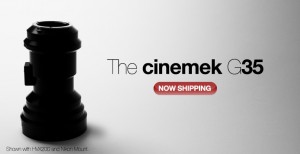
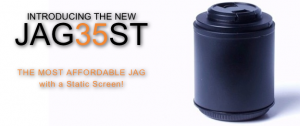
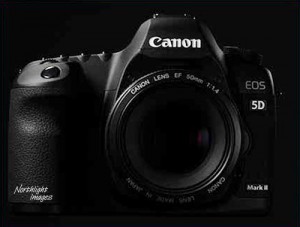
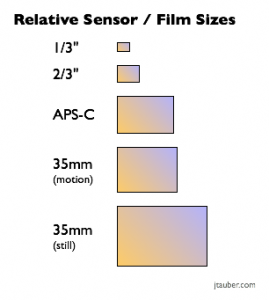
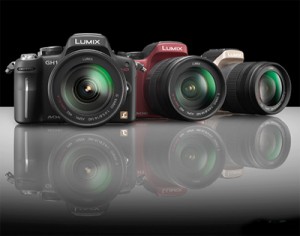
22 comments
Great article 🙂
Maybe if the DSLR manufacturers added timecode output to the DSLR camera you would be closer to the death of 35mm Adaptors? So you could use proper audio recording devices when necessary.
Hi Philip,
I have a sony hc1e (hdv) and was thinking of getting a Panasonic GH1…
Do you think that in videos of “almost only talking heads” a canon hf100/or/hf20 with a 35mm adaptor is tipically better than a GH1? I was mainly wanting the DOF/cinema look.
Can you connect an external microphone on the GH1 body (someone wrote that the plug is 2.5mm), do you know how it works?
As for the cinematic low DOF on these DSLR video cameras, i just found this movie on vimeo and i think you are going to like to see it if you didn’t saw it already – http://vimeo.com/4642425
congrats on your work including sharing your knowledge and experience. thanks.
Rgds,
ZN
Great read Philip,
I have had the brevis, and now letus. I agree that the landscape of pro video is right on the cusp of massive change. Over the past year and a half I have done many projects on the RED camera that would have otherwise been shot on 35mm film or HD video (as well as doing productions on film & video).
I think every corner of the film/tv industry will be affected by RED/Scarlet in a big way. From commercials, to indie films, music videos and of course features.
Although RED has had it’s detractors about it’s post workflow I think that with Scarlet and the next round of codec/workflow/post integration it will be a common standard in small and large production companies because of it’s bang for buck price point. What I am really interested to see is how the established manufacturers of the current gear we use in the 10k to 20k camera gear category (Sony/Pana/Letus etc) respond to a product that falls in that price range with the image quality that RED has.
Time will tell.
Great post. DSLR’s have a long way to go before the adapters are dead. The lack of audio as Terje mentioned is an issue.
Perhaps video cameras will start adopting features from the new DSLRs.
You don’t need timecode, you just need a sync slate. Gets you the same thing.
really great read, and really helped me know a bit more about the whole 35mm adapter scene. Would love to pick one up for my HV20, but that will have to wait til I know I have work after June 😉
I love the idea of having a one-shot deal where I’d only have to carry around 1 camera to do both stills and video, and maybe a lens or two, but as you’ve pointed out, there still needs to be more progress on the video side of things. For one, I’d love to see better options for recording formats, (ie: not just limiting 24p to 1080 mode, but also in 720)
Quite frankly, I’m excited for the future!
Brett Noe: sync slate aka clapper boards? LOL. Have you ever tried recording long shots syncing audio with video just using sync slate? What if you have drifting between does two units? Do you think timecode output found on more expensive equipment is there just for fun? And why do you want to spend lots of time syncing all shots manually?
I don’t usually shoot really long shots, and drift doesn’t happen if all device settings are correct. I tend to shoot short form corporate and film style so short clips are the norm.
Timecode on film is handled using a smart slate, so you still have to line it up manually.
I don’t think we’ll see SMPTE timecode anytime soon.
Philip:
Thanks for the extremely well written piece and for taking the time to share all your experiences. You have certainly help elevate me and saved me countless hours of research time.
http://digitaljournalist.org/issue0903/tech-tips.html
Canon’s reply to audio sync issues.
Nice post, Philip. I could be wrong, but I think if you set the 5D to record to an external HDD, the record limit goes up to just under 30 mins.
I’m in the process of learning shooting video, from a stills shooter background. I’ve used a 5D and currently I’ve borrowed an XH G1. Love what you do with the Letus and I’m worried that I might buy an XH and Letus only to have Canon bring out a killer hybrid.
So the question I ask myself is do I wing it with a 5D with work-arounds or cough for a pro video camera and Letus….
Thanks for the article!
but I don’t think the hdmi out is full hd is it?
Depends what you want from your work as I say in the article. For most work the G1 and Letus would be amazing for most things.
I’ve heard it’s not. Wanted to use that for critical focus monitor but it seems to be ressed down.
A very interesting post. I agree that this new category does not pose any immediate threat to the 35mm adapter market. It remains to be seen whether the big boys are paying attention to the niche that the 35mm adapter has been catering to. As you mentioned, video was an afterthought on these new DSLR’s. An afterthought designed to help differentiate products in an already mature marketplace. What will really determine the future of this potential convergence is cost. If the Canon’s, Sony’s, Panasonic’s, and JVC’s of the world can figure out a way to make these large sensors on the cheap, I wouldn’t be surprised if the Red Scarlet vision, of a modular unit doing both stills and video will become more commonplace. I’m skeptical, however, about the prospect of this convergence actually taking over. I think that video and photo are very different arts and as a result, the needs of the artist will always require different tools.
Most apt article with couldn’t-agree-more content.
But I’m waiting for the day when some DSLR company brings out a still camera with raw video footage out.
Do you think I’m waithing in vain?
A good read, I always enjoy your website, but with so much discussion about DOF adapters, you continue to leave out the full line of adapters made by P+S Technik. They were the first kid on the block with the Mini35 and Pro35, and now with the Pro35 1/2″ for the EX3 they are continuing to provide the most high end, well engineered lens adapters on the market. From Working with and educating people on the Letus and P+S Technik products in a rental environment for the past several years, I must attest that for build quality, simplicity, and stability P&S still takes the cake in production. It pains me that the Letus guys can’t even put out a Nikon mount that doesn’t ‘loosen up’ after every handful of rentals. However, Letus gear still hits that price point for many, and the proof is in the picture.
The 5D is a fun tool, I certainly cannot wait enough for June 2nd, nor can I wait for that yet to be released, game changing, 1080P-4K based video camera with interchangeable lens mounts and a super35 sensor, at a sub $8000 price point that isn’t awkward and bulky to operate. Is it only a matter of time before one of the big guys gets the design right?
Very simple reason why I leave them out…is I don’t have one! Yes, I should have mentioned them here, but most people reading this are generally of lower budget and don’t use the P&S. Yes Nikon mount on Letus is pain! Why can’t we have one like they have on Nikon cameras, as in perfect?!
In my opinion DSLR are cool, but have an image that doesn’t look like cinema, but like videoclip and documentary.
Cause the resolution-definition of the image is really high. But it got a cold/fake effect. I don’t like at all.
The film has a paste more grainy (I hope the words are right, sorry for my english!) then the new cold super defined image made by the dslr.
Red Epic got more definition then a dsrl, but it still more grainy, like a true film is.
I own a Sony Pmw ex3, and a Letus Elite.
I’ve bought this camera after watching “Return to Syberia” made by Philip Bloom, and I think this camera, with the Letus, is much more cinema-style then a dslr.
I don’t mean is better or worse, I just mean that it look more lie a cinema movie.
I think that the best camera that people can buy with a “consumer” price is the Sony F3.
Then the best can be only high profile Cinealta or Red One/Epic etc…
This is my modest opinion.
Bye!